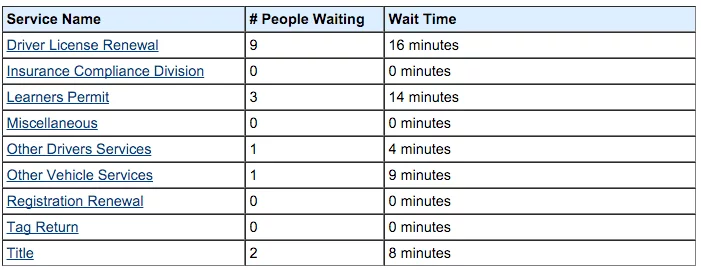Lean Metrics
Lean Metrics are a standard set of measures that monitor the performance of processes of a system. Common measures include Lean Time, Cycle Time, and Throughput.
Recently, I had the unfortunate task of renewing my driver’s license. It’s been 10 years since the last renewal and I remember the last time I was at the Maryland MVA (Motor Vehicle Administration) office, the wait was close to an hour. We all know how painful the experience is. You stand in line, you get to the front of the line, they tell you to go fill out some paperwork and then to get back in line. I will use experience to describe lean metrics.
Lead Time
Lead time is the time between the initiation and completion of a production process. In my case, I left the office at 09:00 and arrived back at the office at 10:00. The lead time to renew a driver’s license was 60 minutes. Given my goal, the shorter the lead time the better.
Cycle Time
You or your customer define cycle time, the total time from the beginning to the end of a process. Cycle time includes process time. Process time is when you act upon a unit to bring it closer to an output. Cycle time also includes delay time, the time a unit of work is waiting to take the next action. The shorter your cycle times (including delays) the shorter your lead time.
My cycle times included:
- 15 minutes – driving to MVA office
- 5 minutes – stand in initial line to be added to the proper queue
- 16 minutes – wait time to get the front of the line
- 5 minutes – actual renewal processing
- 4 minutes – wait time to be given the new driver’s license
- 15 minutes – driving back from the MVA office
My hat comes off to Maryland MVA. On their website, they provide current wait times at the different locations. I took a screen grab before I headed to the local MVA branch. This feedback was very valuable. Given the service I needed, it allowed me to provide an estimate of my time away to others I was going to be working with today.
Throughput
Throughput is the the amount of material or items (people in this case) passing through a system or process per time unit. With an average cycle time of 5 minutes for the renewal process, the throughput in 60 minutes would be 12 people. At first glance, I didn’t see any real bottlenecks or delays in their system. Given what I saw, I believe 10 people an hour is a reasonable throughput.
Understanding Lean Metrics
I hope this brief real world example of lean metrics is valuable to you. When I was at a session for value stream mapping at Agile 2015, the poor guy leading the session kept getting lead time and cycle time mixed up. The people in the room heckled the hell out of him. After reading this, that should never happen to you.


Comments (2)
Chris
Whilst I realise this was simply an example to help explain the concepts, it does also help illustrate another point about metrics…
Last year it took 3 days lead time for me to receive my renewed license – shocking! But wait, the only production cycle I was involved with was the 5 minutes it took me to complete the online renewal form. The rest of the time (from my perspective) was simply waiting for it to arrive in the post, which it did 3 days later.
So, which is better? A 1 hour lead time or 3 day lead time? I know which I preferred.
Chris, yes, I was just trying to illustrate the concepts. I almost went for the online renewal. When I realized I would have to go to a eye doctor and that eye doctor would have to log into the MVA system to provide my eye exam results, I opted for the trip to the field office.
Given your scenario, I would have chosen the 3 day lead time. Total time for you was only 5 minute investment for the same value. There was too much risk and uncertainty for me. That said, if I move or need my tags renewed, I can guarantee I’m going the online route.